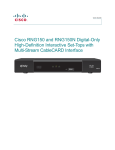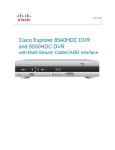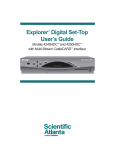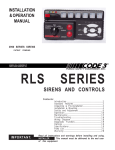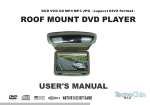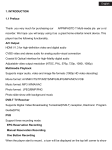Download User Guide - Connecting the Explorer 8300HDC Digital Video
Transcript
Connecting the Explorer 8300HDC Digital Video Recorder ® TM 1 What’s on the Front Panel? EXPLORER® 8300HDC CH + GUIDE POWER VOL - INFO VOL + CH - SELECT EXIT LIST AUX INPUT L AUDIO R 1 VIDEO 2 3 4 5 6 7 8 9 10 11 12 T12141 1 Power Turns the 8300HDC on and off 2 Video and Audio Input Connects to video and left/right (L/R) audio outputs of an external device to deliver the audio and video to a TV or other device 3 List Displays the list of recorded programs 4 Exit Exits menus, the on-screen guide, and program information 5 Info Displays a description of the selected program. This button is available from the on-screen guide and while viewing a program 6 Guide Accesses on-screen services, such as the on-screen guide, video-ondemand, or pay-per-view 7 IR Sensor Receives the infrared signal from the remote control 8 LED Display Displays the selected channel number and time of day. The LED also displays the following: • • • • • • 9 VOL + and VOL - Message ( ) HDTV Power ( ) Output Resolution (1080i, 720p, 480p, or 480i) RECORD AUTO - Automatically outputs native scan rates that your TV can accept Increases and decreases the volume 10 CH + and CH - Scrolls up and down through the channels 11 Select Provides access to your on-screen selection 12 USB Port Connects to external equipment, such as a keyboard or mouse (reserved for future use, may not be available on all 8300HDC models) 3 2 What’s on the Back Panel? 1 Cable In Connect the coaxial cable that delivers the signal from your cable service provider 2 Cable Out Connect a coaxial cable to send analog audio and video signals to a TV or VCR. These signals are standard-definition TV (SDTV) video and stereo audio 3 PrPbY/V Connect the 8300HDC (in HD mode) to the component video input (YPrPb) on the HDTV. When the 8300HDC is configured for SD mode, the Y/V portion of the component video output connect s to the composite video input of an SDTV. See Connections for an HDTV and VCR on page 6 or Connections for a Standard-Definition TV and VCR on page 7 for complete details 4 Digital Audio Out Connect an RCA cable to send a digital audio signal to a surroundsound receiver or other digital audio device 5 Out 2 (Secondary Video and Audio Out) Connect to either a VCR for archiving saved content from the 8300HD or connect to another set of inputs (composite) on your HDTV 6 Audio Out (LEFT and RIGHT) Connect RCA cables to send analog audio signals (lef t and right) to the stereo outputs of an HDTV 7 Optical Audio Output Connect an optical cable to send a digit al audio signal to a surroundsound receiver or other digital audio device 8 S-Video Out Connect an S-Video cable to send an S-Video signal to your TV or VCR. This signal is standard definition but higher quality than other SDTV connections 9 IR (This connector reserved for future use) 10 HDMI Connect the HDTV HDMI™ connector to the HDMI port. HDMI supports both digital audio and video. May be used to connect to a DVI interface using an adaptor for video and sep arate audio connections. You can use any of the following audio connections: Digital Audio Out (4), Audio Out [LEFT and RIGHT] (6), or Optical Audio Out (7) 11 CableCARDTM Slot for CableCARD multi-stream card for decrypting subscription digit al channels. Obtain the multi-stream card from your cable service provider . 12 SATA Connect to an external Serial ATA (SATA) hard disk drive for expanded recording capacity. Check with your cable service provider for a list of approved hard drive models for use with the 8300HDC 13 1394 Outputs Connect to display devices equipped with 1394 input s. These connectors might not be available on all 8300HDC models. When you connect the DVR-DVD to your TV using 1394, you must make additional video and audio connections to your TV to receive analog signals 14 AC Outlet Connect the AC power cord from another device, such as a TV 15 AC Power Input Connect the power cord to deliver power to the 8300HDC 4 3 Connecting the 8300HDC To connect your 8300HDC to your entert ainment devices, complete these steps. 1 Determine if your TV is HD or SD and whether it is wide screen (16:9) or standard screen (4:3). See page 8 for more information. 16 4 or 9 3 Make the connections for your TV and VCR as follows: 2 D 3 • If you are using an HDTV, see page 5 and the connection diagrams at the end of this guide. • If you are using an SDTV, see page 5 and the connection diagrams at the end of this guide. • If you want to archive some programs to VCR tape, see pages 5 and the connection diagrams at the end of this guide. Identify the additional devices you will connect to the 8300HDC and TV. See pages 9 through 14 and the related user guides for more information. DVD VCR Home Theater D-VCR Other External SATA Drive Plug the 8300HDC and the TV into an AC power source that is not controlled by a switch. 4 Do not turn on the 8300HDC or TV yet. POWER 5 6 It may take several minutes for the 8300HDC to receive the latest sof tware, programming, and service information. Wait until you see one of the following displays on the front panel of the 8300HDC that indicates that the update is complete: • Current time • Four dashes (- - - -) Note: If four dashes are displayed, you must call your cable service provider to get the 8300HD authorized. Set up your set-top for HDTV by completing the HD Setup Assistant: 7 5 • Make sure the 8300HDC and the TV is On. • Follow the on-screen instructions to complete the HD Setup Assistant. Set up Widescreen (16:9) or standard screen (4:3) depending upon your TV type. See page 8 for more information on the aspect ratio. • At the conclusion of the on-screen instructions, begin watching TV. 4 Connections for an HDTV and VCR To use the 8300HDC with an HDTV, you must make one of the following connections to view the HD content. In addition, you can make connections to a digit al or analog VCR to archive recordings to a VCR tape. Refer to your TV and VCR users guides and the cabling diagrams in this guide for more det ailed connection information. Note: The labeling on your 8300HDC may vary slightly. DVI HDMI Required Connections to an HDTV (use one) 8300HDC Connections Some HDTVs have a High-Definition Multimedia Interface (HDMI) connector. The HDMI connector provides both a digital video and audio connection. See the connection diagram on page 9 for an example. The HDMI connector can provide the connection to an HDTV with a DVI input. If your HDTV has a Digital Visual Interface (DVI) connector, you will need an HDMI-to-DVI adapter, and you will need to connect a sep arate audio connection. See the connection diagram on page 10 for an example. DVI L R Adapter Needed The Y/V PbPr connectors can provide high-definition component video signals to an HDTV. PrPbY/V HDTV Connections Y Note: Use the HD Setup Wizard on the 8300HDC to set the HD mode and select the output video format that will matches the full capabilities of your HDTV. Pb Pr L R L R 1394 RGB See the connection diagram on page 11 for an example. Check with your cable service provider for information about acquiring an RGB adapter, or you can purchase the adapter at your local electronics supplier . Some HDTVs have 1394 connectors. If you connect to your HDTV using 1394, you also need to connect separate video and audio connections to your HDTV. See the connection diagram on page 19 for an example. Optional Connections to a VCR (use one) For VCRs with Video and Left and Right audio connectors, you can use the Out 2 connectors (Video, Left, and Right) on the 8300HDC. See the connection diagram on page 13 for an example. VCR R Some HDTVs have only RGB connectors. If you have one of these HDTVs, you need an RGB adapter. For VCRs with S-Video and Left and Right audio connectors, you can use the S-Video Out and the Out 2 Left and Right connectors on the 8300HDC. For Digital VCRs, you can use the 1394 out connector on the DVR-DVD. G H B V RGB and Audio Adapters Needed Pr Y Pb 1394 Pb L Pr VIDEO Y/V 8300HDC Connections R VCR Connections OUT 2 A L U D I RO L VIDEO IN VIDEO OUT 2 S-VIDEO OUT L R R AUDIO IN L R S-VIDEO IN 1394 6 5 Troubleshooting If the 8300HDC does not perform as expected, the following tip s may help. If you need further assistance, contact your cable service provider. No Picture • Verify that the power to your TV is turned on. • Verify that your HDTV is in HD mode. If necessary, run the HD Setup Assistant to select HD mode. • If the 8300HDC is plugged into a wall switch, verify that the switch is in the ON position. • Verify that all cables are properly connected. • If your system includes a VCR or stereo, verify that you have properly connected them to the 8300HDC. • Verify that the 8300HDC is set to the proper screen type and resolution. No Color • Verify that the current TV program is broadcast in color. • Adjust the TV color controls. • If you are using a component video connection (PrPbY/V), check that all connectors are completely plugged into the 8300HDC and TV. No Sound • If your setup is using HDMI, check Audio Digital Out Settings. This should be set to HDMI to pass sound through the set settop HDMI connection. • Verify that the volume is turned up (analog audio only). • Verify that the mute function is not on (analog audio only). Automatic Software Updates The TV screen displays a message that indicates the 8300HDC is automatically updating it s software. Wait for the current time to display on the front p anel of your 8300HDC before continuing. When the front p anel displays the time, the update is complete. 9 6 Frequently Asked Questions About HDTV What is Digital Television? Digital television (DTV) is a huge leap forward in television technology comp ared to analog television that has been widely available since the 1940s. DTV is delivered and displayed using digital encoding, similar to the way a PC operates. By using digit al technology, there is no variation in picture and sound quality from the origination point until it is displayed on your television. You always receive a high-quality picture without the wavy lines or st atic you might sometimes get from a weak analog signal. Because DTV receives and displays digit al images that contain many times more picture element s (pixels - the small dots that make up the color image on your screen) than st andard analog television, you can get a sharper on-screen image than with analog. Additionally, DTV supports CD-quality sound. DTV includes SDTV (Standard Definition Television), EDTV (Enhanced Definition Television), and HDTV (High-Definition Television). That means that all HDTV is digit al, but not all digital TV is high-definition. A high-definition program must originate in HD format and be broadcast in HD format. Having an HDTV system does not mean that everything you watch will be in high-definition. Getting the signal from digit al cable also does not mean it is high-definition. What is Standard-Definition Television? Standard-definition television (SDTV) is basic digit al television programming delivered by cable. Typically, the SDTV screen is the same, nearly square shape as an analog television screen. Digital images on an SDTV set are crisp and clear—noticeably better than on a st andard analog television set using an antenna to receive over-the-air signals. What is High-Definition Television? High-definition television (HDTV) is a completely new way to send and receive television broadcast signals. HDTV images are made up of pixels that are much smaller and closer together than those used in standard analog television, and there are millions of them. Thus, HDTV can display five to six times the detail of analog television to deliver picture quality that is much more realistic, dimensional, and precise. SDTV programs can be viewed on an HDTV. Another feature of HDTV is digital surround sound using Dolby® Digital, which is the same technology used to produce the sound you hear in movie theaters. Are Local TV Stations Broadcasting in HDTV? Many local TV stations are transmitting digital signals. However, transmitting a digital signal does not mean transmitting an HDTV signal. Some stations are using the new bandwidth to broadcast several standard-definition channels. Most stations, once they begin broadcasting in digit al, are offering HD content from their parent network (for example, CBS, ABC, NBC, Fox, WB, UPN, and PBS). What is a CableCard? A CableCard is a multi-stream card that allows the set-top box to decrypt subscription digit al channels. The card fits into the CableCard slot on the back of the 8300HDC (see p age 3 for the location of the slot). Where Are the Connection Diagrams? The diagrams at the end of this guide show examples of common ways to connect the 8300HDC to your HDTV, DVD, and home theater receiver. However, these diagrams do not show every possible combination of devices. Refer to the user ’s guides that came with your other electronic devices for further information. What Cables Do I Need? Some of the cables and adaptors shown in the diagrams may not be included with the 8300HDC. Some of the required cables are shown in the connection diagrams . 10 7 Picture Formats What is the Difference Between a Standard-Screen and a Wide-Screen HDTV The type of screen your HDTV has (wide screen or st andard screen) determines how the 8300HDC displays programs on the screen. The picture format for an HDTV is a combination of aspect ratio and screen resolution and is different for standard-screen and wide-screen HDTVs. What is Aspect Ratio? An aspect ratio is the ratio of the width to the height of the TV screen. The aspect ratios differ because the television industry manufactures both st andard-screen and wide-screen HDTVs to appeal to consumer viewing preferences. What is the Screen Resolution and Scan Rate? The screen resolution indicates the amount of det ail that the picture displays. Resolution is identified by the number of display lines on the screen. The techniques that an HDTV uses to “paint” the picture on the screen are referred to as progressive and interlaced. With the progressive method, every pixel on the screen is refreshed simult aneously. The interlace method involves refreshing pixels in alternation — first the odd lines and then the even lines. For advance setup, select the scan modes that your TV can support. Refer to your DVR and HDTV user’s guides to choose the proper scan rates (480i, 480p, 720p, 1080i) for your setup. For example, a resolution of 1080i indicates that the screen shows 1080 lines in an interlaced display, and 480p indicates that the screens shows 480 lines in a progressive display . Notes: • The screen resolution (1080i, 480p, and so forth) is sometimes referred to as the scan rate. The terms are interchangeable. • You can stretch and zoom the displayed picture using the built-in cap ability of the 8300HDC by pressing the # key on the remote control. Refer to your DVR user ’s guide for more information on this feature. A standard-screen HDTV has a 4x3 aspect ratio. The screen is 4 units wide for every 3 units tall. A wide-screen HDTV is one-third wider than a standard-screen HDTV. The screen is 16 units wide for every 9 units tall. 16 4 3 A screen resolution of 480p or 480i fills the screen. 11 9 A screen resolution of 720p or 1080i fills the screen. 8 Connecting the 8300HDC to an HDTV with an HDMI Connector WARNING: Electric shock hazard! Unplug all electronic devices before connecting or disconnecting any device cables to the 8300HDC. Required cables: • 1 HDMI-to-HDMI cable Important Notes Regarding the HDMI Interface on the 8300HDC The HDMI interface automatically configures the audio output for a format supported by the television. Because not all TVs support the Dolby® Digital input, the HDMI interface may automatically select a 2-channel stereo audio configuration instead of Dolby Digit al, which it carries over to the other digital audio outputs of the 8300HDC. This prevents your home theater system or Dolby Digital decoder from providing the full Dolby Digit al surround-sound effect. You can override this configuration by completing the following step s. 1. Press SETTINGS on the remote control to open the General Settings menu. 2. Press MOVE UP or MOVE DOWN to select the option Audio: Digital Out. 3. Press MOVE RIGHT to select HDMI. This setting will send Dolby Digital audio to the HDMI, DIGITAL AUDIO OUT, and OPTICAL AUDIO OUT connectors on the 8300HDC. Notes: • • If the TV is not Dolby Digital capable, it may not produce audio through its speakers when the Audio: Digital Out setting on the 8300HDC is set to Dolby Digit al. You can either switch the Audio: Digital Out setting back to HDMI when you are not using the home theater or Dolby Digital decoder, or you can connect the baseband audio output s (OUT 1 Audio Left and Right) to the TV. Digital content is encrypted with High-Bandwidth Content Protection (HDCP) on the DVI/HDMI port. The HDC DVR is not compatible with devices that do not support HDCP. You must use either the YPrPb or 1394 connection to connect the DVR to these devices. 12 9 Connecting the 8300HDC to an HDTV with a DVI Connector WARNING: Electric shock hazard! Unplug all electronic devices before connecting or disconnecting any device cables to the 8300HDC. Required cables: • • 1 HDMI-to-DVI or 1 HDMI-to-HDMI cable and 1 DVI adapter 1 audio Left/Right cable Notes: • • • When you connect the HDMI connector to the DVI connector on your HDTV, you need an HDMIto-DVI adaptor and a separate audio connection. Digital content is encrypted with High-Bandwidth Content Protection (HDCP) on the DVI/HDMI port. The HDC DVR is not compatible with devices that do not support HDCP. You must use either the YPrPb or 1394 connection (which uses Digit al Transmission Content Protection, or DTCP) to connect the DVR to these devices. Also refer to the Important Note Regarding the HDMI Interface on the 8300HDC on page 9. 13 10 Connecting the 8300HDC to an HDTV with Component Input (PrPbY/V) WARNING: Electric shock hazard! Unplug all electronic devices before connecting or disconnecting any device cables to the 8300HDC. Required cables: • • 1 set component video cables (PrPbY/V) 1 audio Left/Right cable 14 11 Connecting the 8300HDC to a Home Theater System with Component Input (PrPbY/V) Required cables: • • 3 sets component video cables (PrPbY/V) 2 coaxial digital audio cables WARNING: Electric shock hazard! Unplug all electronic devices before connecting or disconnecting any device cables to the 8300HDC. Back of Home Theater Receiver DIGITAL AUDIO TV/CABLE DVD VIDEO 1 S-VIDEO S-VIDEO S-VIDEO S-VIDEO VIDEO VIDEO VIDEO VIDEO L L L L AUDIO AUDIO AUDIO AUDIO R R COMPONENT VIDEO 2 4 Back of Home Theater Receiver TV/CABLE DVD VIDEO 1 S-VIDEO S-VIDEO S-VIDEO S-VIDEO VIDEO VIDEO VIDEO VIDEO Y Y PB PB PB PR PR PR 3 DIGITAL AUDIO Y MONITOR 1 COMPONENT VIDEO Y Y Y PB PB PB PR PR PR MONITOR IN R OUT 1 IN 2 OUT S-VIDEO OUT VIDEO OUT R 1 2 3 4 L L L L AUDIO AUDIO AUDIO AUDIO R R IN R OUT 1 IN 2 Back of DVD Player S-VIDEO OUT DIGITAL OUT COAXIAL VIDEO OUT OUT AUDIO OUT R L Y PB VIDEO OUT R OPTICAL DIGITAL OUT Back of HDTV AUDIO CENTER CHANNEL IN ON S-VIDEO OUT PB COMPONENT VIDEO OUT/ PROGRESSIVE SCAN DVI/HDCP IN T11135 OFF AUDIO IN DVI/HDCP S-VIDEO R L ANT (75½) VIDEO Y VIDEO L/ MONO AUDIO PB L PR AUDIO R 15 L/ MONO PB L R PR AUDIO R VIDEO-1 VIDEO-2 HD 1 T11136 Y IN OUT R AUDIO IN ANT-1 OUT HD 2 IN ANT-2 Note: This connection assumes that audio is provided by the home theater speakers. 12 Connecting the 8300HDC to a Stereo VCR and HDTV (optional) WARNING: Electric shock hazard! Unplug all electronic devices before connecting or disconnecting any device cables to the 8300HDC. Required cables: • • 1 RF coaxial cable 2 sets composite A/V cables Note: This connection allows for archiving to the VCR and for watching VCR tapes on your HDTV. To watch HD content, use the HDMI, PrPbY/V, or DVI connector. 16 13 Connecting the 8300HDC to an External SATA Hard Disk Drive (optional) Complete the following steps to install a SATA drive. 1. Make sure that both the 8300HDC and the external SATA drive are unplugged from power. 2. Connect the data cable for the SATA drive to the 8300HDC. 3. Plug in power to the external SATA drive. WARNING: Electric shock hazard! Unplug all electronic devices before connecting or disconnecting any device cables to the 8300HDC. 4. Plug in the 8300HDC power cord, and then turn on the 8300HDC. 5. Follow the on-screen instructions. One of the following occurs: • If it is a new drive or one used on another device, you are asked to format it. • If the drive is formatted and will work with this 8300HDC, you get a confirmation that the drive is working. Guidelines for Using the External SATA Hard Disk Drive The external SATA hard disk drive requires continuous power. If the SATA drive loses power while the 8300HDC is plugged in, the 8300HDC may stop recording or not provide enough sp ace for future recordings. Follow these guidelines for using the SA TA drive: • Do not plug in the power cord for the SATA drive to a switched outlet or to the AC outlet on the 8300HDC. • Do not turn off, disconnect, or unplug the SATA drive while the 8300HDC is plugged in. Recommendations for the SATA Drive Contact your cable service provider for a list of approved external SA TA hard disk drives. At a minimum, your SATA drive should have these cap abilities: • External SATA Connector - SATA II: Cable and Connector, Revision 1.0 (www.sata-io.org for more information) • Drive Speed: 7200 RPM (5400 RPM without Multi-room); 133 MB/sec • Capacity: Only one SATA drive can be connected to the 8300HDC. The 8300HDC will not support a separate port multiplier. • SATA Drive Power: The SATA drive should power on when plugged in and should not be controlled by a switch. 17 14 Setting up the Set-Top Box for High Definition Viewing ................................................................................. To run the High Definition Setup Assistant: The first time the viewer turns on the power to the set-top box, Passport Echo presents the HD Wizard. 1 If the message is clearly visible, press the RIGHT ARROW to begin the High Definition setup. Passport Echo displays the Output Formats tab. Passport Echo will display a message in each of four output formats. 2 If the message is clearly visible, press the RIGHT ARROW to continue. You can press the Back key at any time to return to the previous screen. Passport Echo displays a message asking “Is this message clearly visible?” 3 If the message is clearly visible, press the A key within 10 seconds. Passport Echo will display the message in another output format. Again, if the message is clearly visible, press the A key within 10 seconds. Repeat. 316 Passport Echo Customer Service Guide 15 ...... ................................................................................................................. After Passport Echo cycles through four output formats, it displays a message indicating the formats that you indicated were clearly visible on your television. 4 Press the RIGHT ARROW. Passport Echo displays the Screen Type tab. 5 Do one of the following: • If you are watching a wide screen TV, press the A key. • If you are watching a standard screen TV, press the C key. (This procedure uses a wide screen as an example.) Passport Echo displays a message indicating your response. 6 Press the RIGHT ARROW. Passport Echo displays the Aspect Ratio tab. (Optionally, you can press Back to return to the previous screen.) Passport Echo Customer Service Guide 317 16 Setting up the Set-Top Box for High Definition Viewing ................................................................................. 7 Read the Aspect Ratio tab, then press the RIGHT ARROW to continue. 8 Do one of the following: • To center the screen image and display sidebars on each side, press the A key. • To stretch the image to fill the screen, press the B key. • To zoom the image to fill the screen, press the C key. Passport displays your selection and indicates that the Aspect Ratio setup is complete. 9 Press the RIGHT ARROW. Passport Echo displays a summary of your high-definition configuration choices. 318 Passport Echo Customer Service Guide 17 ...... ................................................................................................................. 10 Review the summary. • If the summary does not reflect your preferences, press the LEFT ARROW to start the procedure over. • If the summary reflects your preferences, press the A key. If you do not follow the High Definition Setup Assistant procedure, Passport Echo will display a message indicating that the setup was skipped and that default settings will be applied. Important note: In choosing all output formats ( 480i, 480p, 720p and 1080i) the converter will display a blank screen or a distorted picture when changing to the different format associated with the TV channel and TV program being watched. (Example: Changing from a HD channel that is broadcast in 1080i and going to a non HD channel that is broadcast in 480i.) Optimal setting for your HD or or HD DVR is either 720p or 1080i, depending on your TV’s capabilities. Passport Echo Customer Service Guide 319 18



















